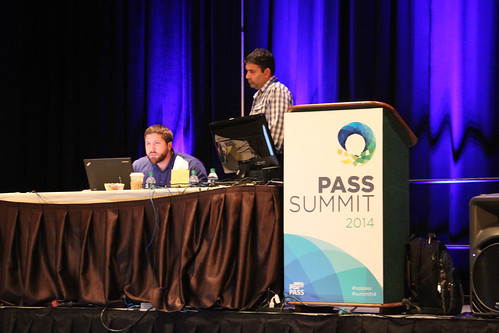Since I decided I did not want to be awarded again as a SQL Server MVP, I wanted to ask some fellow MVPs a couple of questions about the MVP program. I asked the following questions
- How long have you been a SQL Server MVP?
- What is the best part of the MVP program?
- What are the two main reasons that you go to the MVP summit?
- If you were not a MVP anymore, what would you miss the most?
The following people answered: Adam Machanic, Rob Farley, Paul Randal, Alejandro Mesa, Hugo Kornelis, Hilary Cotter, Itzik Ben-Gan, Brent Ozar, Mladen Prajdic, Arnie Rowland, Jamie Thomson, Thomas LaRock, Kevin Kline, Rod Colledge, George Mastros, Jes Borland, Louis Davidson, Denny Cherry
Originally I had each MVP's answer separately but then I noticed that the 4 questions were repeated for every MVP, I decided to just list the question once and have all the answer listed under the question. Now all you have to guess is who gave what answer :-)
A big thank you to the MVPs that took time answering all these questions
Here are the answers...enjoy.
1: How long have you been a SQL Server MVP?
Since October, 2004
Since October 2006.
7 years
I have been a SQL Server MVP since Jan, 2007. I believe it is 8 years by now.
Since January 2006. So I am now in my ninth year. (Wow!!)
I have been an MVP for about 13 years now.
15 years
5 years - I got the MVP award back in 2009, and I've been tickled pink every time I get renewed.
since 2010
8 years
8 years I think
I earned my first MVP in April of 2009, so this year is my sixth consecutive award.
I was first awarded the MVP status for the 2003 cycle.
I've been an MVP since January 2010 - This is my 5th consecutive year
It will be 4 years in October.
I was awarded for the third time in April 2014
10 years so far...
6 years
2: What is the best part of the MVP program?
Interacting with other MVPs! I've learned a huge amount over the years from numerous MVPs -- famous ones like Itzik Ben-Gan, retired ones like Steve Kass and Anith Sen, and I can't forget some guy called Denis Gobo...
This is more answered by the fourth question. The best part of the program is not really something provided by Microsoft but the community that has formed with the SQL MVPs. But on the assumption that you want an answer that relates to something Microsoft provides, I'll go with the mailing list. Everything discussed there is under NDA, and it's a great place to learn and see what's going on. It's through the mailing list that Microsoft talks to MVPs when they want our opinion on some new feature, reflecting the fact that there are lots of people with Microsoft who do see us as a valuable group of people (not that non-MVPs are not - but the NDA needs to be there).
The free MSDN subscription
For me the best part is to have the opportunity to meet other MVPs, like you, that I have followed for long time either reading their blogs, forum answers, books, etc.
I also like the free MSDN subscription, the interaction with the SQL Server development group and the private list.
I hope you're not forcing me to pick just a single thing, because I can't - there are three things that I all consider to be one of the three best parts. These are, in no specific order: the MVP mailing list (I think the existence of this list is public, so you can include it in your post); the MVP summit; and all the contacts and opportunities that have opened to me through being in the MVP program and networking with other MVPs. (see below for a longer explanation of this)
The best part is the distribution list and being able to pick people brains with questions that I am too lazy to research or can't get good answers about. A close second is the recognition it gives me in getting work. Being an MVP means that I can screw up far more than regular folks and get a pass:)
Industry recognition and MSDN
More chances to talk to Microsoft employees, who are some of the smartest people I know. Forget talking to other MVPs - if you want to do that, go talk to them. You don't need to be an MVP to talk to another MVP - just walk right up to them at any SQLSaturday. They're friendly, open people who love helping others. After all, that's how they became MVPs!
the people you get to meet
Access to many on the product teams, and most especially, the global SQL MVP community.
Free MSDN sub
Best part? - The MVP distribution list. There I get to see many interesting questions and answers as well as interact with the product team at Microsoft.
While there are some monetarily significant benefits, such as the MSDN Universal License, and there are some prestige aspects of the award, the best part of the program for me is the ability to interface with the worldwide MVP community. I especially enjoy the private MVP discussion forum, where MVPs share many of their most challenging and interesting technology questions. MVPs are typically very knowledgeable and, in a sense, a cut above the average IT person. Consequently, I'm always learning from my colleagues in the program and advance my own skills through their efforts.
The best part is the engagement with the product teams at Microsoft - both at the conference itself, and through the email forums
The MVP emails are, by far, the best part of the program. It allows me unprecedented access to some of the fine folks that have actually written parts of the database engine.
I appreciate the direct access to Microsoft. Being able to get answers quickly and understand the future direction of the product is a huge benefit.
The best part is the kind of instant family that you gain when you become an MVP. The communication between the MVPs and Microsoft employees we get is excellent, and not something you can easily get. To be fair, it isn't that much more than you might get at any conference you attend, but it is far more regular and constant.
It is also kind of the worst part too. The fact is, while it is sort of like family, it is different in one very important way. You are family for life. The members of the MVP family have changed over the years quite a bit, and the Microsoft employees we interact with change constantly. The reasons vary, but I am always sad to see people like yourself fade off into the sunset, though at the same time I think it is awesome that people like you have the intelligence to know when things in your real family are more important.
Being able to work directly with the product group on new features and fixing problems with the product
3: What are the two main reasons that you go to the MVP summit?
I haven't attended an MVP Summit in several years, so I guess I have no reasons to go. When I did go I enjoyed interacting with other MVPs in person (usually over way too many beers). I get the same experience at the PASS Summit.
Actually, I haven't been to the last six MVP Summits. I went the first two years I was an MVP, in early 2007 and early 2008, but haven't been back since. It's ever such a long way to go from Australia, and while I love the MVP community, I actually prefer to be at events that include non-MVPs. I've been keen to go, because the interaction with the product group is really good. And of course, hanging out with the other MVPs is terrific. And the sessions on the internal workings of the product.
Socializing. We're usually not around for the Summit (we live in Redmond) and there's usually nothing new presented at the Summit that we haven't already been told some other way.
First to get together with other MVPs, second to interact with other MVPs. :)
The information exchange with the SQL Server dev team, and the many friends I meet there - many of them just once per year, at that summit.
I haven't gone to the summits. A couple of times I went to some MVP events for SQL Server after PASS and was kind of shocked by most of my peers. They were ego maniacs. I might go to the one this fall. I always toy with the idea of going but normally don't. We will see.
Hearing what the developers have to say and meeting my MVP friends (i.e., having beer together)
I don't, actually. I have a commitment with my family that I'll only travel one week per month, and for the last few years, the private MVP Summit has been the same month as public conferences that I'd rather attend. I'm really happy that this year Microsoft chose to host the MVP Summit in Seattle during the same week as the PASS Summit, and I'll be able to attend both. (Without coming home to find my belongings helpfully arranged on the doorstep.)
to see what'll be next. to see friends and (re)connect with others
Same as #2. Networking, personal contacts, and advanced product information. Toss in a smidgen of actually being asked about future directions –though, at times that seems more like a palliative effort than a ‘real’ engagement…
Learn about new stuff coming out, opportunity to grill the folks that build the produc
2 reasons? - To connect with fellow MVPs and to learn more about where MS is heading (and taking us with them, should we choose to go!)
While the MVP Summit is a great yearly event, it's not on my "must-attend" list. I think that I manage to attend about 60% of the time. The two biggest reasons I DO like to attend the Summit are:
1) ...to make introductions with the actual people leading the various efforts for each specific Microsoft SQL Server feature. Because people move around a lot within Microsoft, I like to make sure I know and get to meet the various program managers who are responsible for key areas of SQL Server product development, planning, and strategy. That way, if I ever have a question about the product, I know who to ask and, conversely, they know me. It's not a channel I exercise frequently - perhaps twice per year. But it's has great utility and value for a person who builds tools based on what Microsoft themselves are building.
2) ...to be a part of the feedback loop. Microsoft provides MVPs a couple avenues for feedback at the Summit. For example, there are often opportunities to see Microsoft's roadmap and future plans and to comment on them. That's cool, especially those times where you actually see Microsoft make a course correction in their product based on your feedback. Another example is when Microsoft provides the MVPs an opportunity to comment on an existing set of features and to influence when and how those features grow.
The Microsoft SQL Server team does appear at other conferences over the course of the year, such as Microsoft TechEd and at the big annual PASS Summit. But I find the MVP Summit is the best place to get some one-on-one time and, in some cases, even make friends with the various team leads for SQL Server. That, for me, is priceless.
To be honest, I've only been once (2010). The travel involved from Australia makes it difficult, particularly when I also go the PASS summit, which is normally around the same time. I will almost definitely be going this year though, so I'm really looking forward to that
I have never been to the MVP Summit, and I regret it each year.
It's a rare conference I go to where I am just an attendee, and I get to sit in on all the sessions and learn tons of cool stuff. I also really like running the hills in Bellevue, WA in the mornings with fellow MVPs.
First, to see everyone in person that I see in email feeds, online, etc. It is always a great week of fun, talking about everything from technical stuff, to entertainment, to a wee bit of politics here and there. The MVPs are a very diverse bunch of folks that have a bit of every personality style so it is a great time.
Second (and the one that makes it a worthwhile expense), to gather material for future writing and future work. Getting information about stuff that is coming allows me to start to plan material I want to work on for the upcoming years.
To see what the product team has coming out in the next release, and to swap war stories with the other SQL Server MVPs
4: If you were not a MVP anymore, what would you miss the most?
Interacting with other MVPs, naturally. The private mailing list (which used to be a newsgroup) has always been, by far, the number one benefit for me.
Good question... ;)
Being an MVP is something I've got used to, and something which has become part of my identity within the SQL Server world. But then again, there are plenty of other things which also contribute to my profile - the style of conference session I give, the fact that I did that song in 2011, and so on.
If I were not an MVP, it wouldn't change what I do, or who I am. I'd definitely miss the mailing list, and the community that has grown up through that, but I think the community would continue somehow, as it does through things like Twitter already. I'm already a long way away from most of my favourite people in the SQL community, and so I wouldn't stop being part of the community.
At the end of the day, I love the fact that Microsoft has the MVP program. I thoroughly enjoy the fact that I am an MVP, and wish more people could be recognised for their own contributions to the community. It saddens me that there are people who feel they have missed out every time they don't get awarded. But the SQL community is stronger than ever today, and MVPs only make up a small portion of that community.
Being part of the MVP group
The MVP summit for sure.
See Q2.
(*) Being an MVP has opened up lots of opportunities to me. Some directly, others indirectly. I started blogging, authoring, and tech editing, all because MVPs asked me to. I started speaking after being invited to attend a conference for free (MVP perk) and seeing how much fun that can be. And many of the places I have traveled to as a speaker are also the result of speaking with other MVPs. (The best example of this was in a bus at the MVP Summit. Niko Neugebauer, who I barely knew at that time but consider a close friend now, sat next to me, and his exact words were "what would it take to get you to speak in Lisbon".
And it's not just community activities leading to more community activities; it has also resulted in extra income. I don't think I would ever have been asked to be reviewer for a website that offers exam training without my tech editing experience. And without my years of speaking experience, I would not have become a Pluralsight author.
The distribution list. It would hurt my ego for a while but I would get over it.
Industry recognition and MSDN
The humor in Conor Cunningham's answers on the MVP email list.
probably the email distribution list
See #2 and 3 above.
For me, the greatest aspect of being a SQL Server MVP is the Global SQL Server MVP Community. An incredible group of very smart and wise folks that are enthused about the technology we work with on a daily basis, and more than willing to freely share their expertise and knowledge
MSDN sub
Miss? - Besides the MVP distribution list, I'd miss the MSDN subscription. I've been getting enterprise software for free for so long I'm not sure I'm ready for the sticker shock should I ever need to pay for something on my own.
Well, I'm a people person. I keep up with a lot of my friends' comings and goings based upon their presence in the MVP discussion forum. In some cases, there are MVPs who are quite active in the forum who do not post regularly on social media sites and so they'd literally fall of my radar without the forums. So I'd have to say that I'd miss the friendships and interesting people most were I no longer an MVP.
I'd definitely miss the email forums, where I can effectively drop in on conversations between some of the great minds in our industry, and the opportunity to ask questions of them
I would miss the status. I have never been one to be particularly impressed by status, nor do I gloat about it. However, being an MVP gives you a certain amount of respect. All of my customers have a sysadmin and a network admin. A few have DBA's, but most do not. They look to me for advice because they know I will take care of them. When I tell a customer that I will take care of them, they can trust that I will, and that I will do it the right way. I am not boastful, but I am confident in what I know (and not shy to say what I don't know). All of this leads my customer in having greater confidence in me and my application.
I'd miss the advance knowledge. It's been nice to have access to early versions of software and provide feedback.
Having something to worry about on October 1, which is my renewal date. I look forward every year to sweating it out...
But seriously. The communication channels being an MVP opens are really valuable. I already mentioned them a bit, but even the information I gather by osmosis at times comes in handy. I don't know how many times I am in a discussion about trying to use or write about some feature in SQL Server, and I realize I know more than I thought I did.
The MVP mailing list as that gives the MVPs direct access to the product group












